Science of the Total Environment ( IF 9.8 ) Pub Date : 2020-09-22 , DOI: 10.1016/j.scitotenv.2020.142450 Guilherme Lopes , Wei Li , Matthew G. Siebecker , Donald Lewis Sparks , Luiz Roberto Guimarães Guilherme

|
Zinc contents exceeding regulatory levels have been documented in several areas in Brazil and elsewhere, especially in sites surrounding mining and smelting sites. Studies involving Zn release and speciation are keys to assess the mobility and bioavailability and thus the potential ecological risk of this element. This study evaluated Zn desorption and speciation from soils affected by mining (soils from a mine area, classified as Technosols) and smelting (mine tailing) activities in Brazil with high total Zn contents, ranging from 1.8 to 8.2%, using a stirred-flow approach and synchrotron-based X-ray absorption spectroscopy (XAS), in order to better assess Zn availability and mobility in these environments. The exchangeable fraction, extracted by 0.1 M CaCl2 solution, represented only a small (<0.5%) portion of the total Zn from soils of the mining site, while accounting for ~80% from tailings of the smelting site. In the mine area, X-ray absorption fine structure (XAFS) showed that Zn was associated with hemimorphite, Zn-ferrihydrite, Zn-phyllosilicates (Zn-kerolite), and Zn-layered double hydroxides (Zn-LDH); this is the first time these Zn precipitate/sorbed forms have been detected in Brazilian mining soils, which have been exposed to tropical conditions. The formation of these insoluble phases of Zn could explain the low Zn desorption from these soils, taking into consideration that Zn-ferrihydrite, Zn-kerolite, and Zn-LDH can lead to a significant decrease of the exchangeable/mobile fraction of Zn in soils. The higher amount of Zn desorbed (⁓80%) from the tailing material located in the smelting site could be attributed to the predominance of weakly bound forms of Zn (~70%). These findings were also seen by analyzing the Fourier Transform (FT) and Wavelet Transform (WT). This study has shown that combining EXAFS analyses with desorption extraction is relevant to better understand Zn mobility and how it is related to Zn speciation.
中文翻译:

结合锌脱附和EXAFS形态分析来了解锌在巴西米纳斯吉拉斯州采矿和冶炼受影响土壤中的迁移率
在巴西和其他地区的一些地区,尤其是在采矿和冶炼厂周围的地区,已经记录到锌含量超过规定水平。涉及锌释放和形态形成的研究是评估迁移率和生物利用度以及由此元素潜在的生态风险的关键。这项研究使用搅拌流评估了受采矿影响的土壤中锌的解吸和形态(矿区的土壤,归类为Technosols)和熔融(矿山尾矿)活动,巴西的总锌含量高,介于1.8%至8.2%之间。方法和基于同步加速器的X射线吸收光谱(XAS),以便更好地评估这些环境中的Zn可用性和迁移率。可交换部分,用0.1 M CaCl 2萃取溶液,仅占矿区土壤总锌的一小部分(<0.5%),而约占冶炼厂尾矿中锌的80%。在矿区,X射线吸收精细结构(XAFS)表明Zn与半晶石,Zn-水铁矿,Zn-页硅酸盐(Zn-硅藻土)和Zn层状双氢氧化物(Zn-LDH)有关。这是第一次在暴露于热带气候的巴西采矿土壤中检测到这些锌沉淀/吸附形式。锌的这些不溶相的形成可能解释了这些土壤中锌的低解吸,同时考虑到锌亚铁水合物,锌钾硅藻土和Zn-LDH会导致土壤中Zn的可交换/迁移分数显着降低。 。从位于冶炼现场的尾矿中解吸的锌量较高(约80%),可能是由于弱结合形式的锌(约70%)占优势。通过分析傅立叶变换(FT)和小波变换(WT)也可以看到这些发现。这项研究表明,将EXAFS分析与解吸萃取相结合对于更好地了解Zn的迁移率及其与Zn形态的关系很重要。


























 京公网安备 11010802027423号
京公网安备 11010802027423号